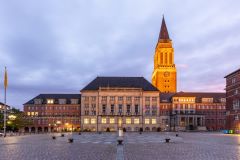The Schleswig-Holstein Musik Festival greets Venice with a hearty “Moin”
Thursday, August 22, 2024

The motto of this year’s Schleswig-Holstein Musik Festival, which runs until 1 September, is “Moin Venedig” – juxtaposing a characteristic North-German greeting with the distant “Pearl of the Adriatic.” Accordingly, the festival focuses on music directly or indirectly related to Venice, as with Gustav Mahler’s 5th Symphony, which (together with Wolfgang Amadé Mozart’s Piano Concerto No. 25) appeared on the program of the opening concert on 7 July in Lübeck. Originally, Mahler’s work (composed in 1901–1902) had little to do with Venice. Nevertheless, the director Luchino Visconti adapted the 4th movement Adagietto for his 1971 film Death in Venice, the script of which he based on a novella by the Lübeck-born author Thomas Mann. In the movie, Mahler’s music is associated with the fictional character of Gustav von Aschenbach and his inner life. Visconti’s interest lies in the transience of human existence, and when the suspension at the end of the movement at long last resolves to a consonance, the gesture closes as much the protagonist’s life as the Adagietto itself.
On 9 August, Claudio Monteverdi’s Vespro della Beata Virgine, first published in 1610 by the Venetian printer Ricciardo Amadino, was performed in the Cathedral of Lübeck. While the work no longer exemplifies the famous polychoral practice of Venice, at least one section (set to the 126th psalm Nisi Dominus) still makes use of ten voices arranged in antiphonal double choirs, which easily recalls the acoustic impression given by several ensembles located in different parts of the church and exploiting the echo potential of the space.
A peculiar small-scale vocal genre, the Venetian gondolier song or barcarolle, likely also originated in Venice, and has been documented since the early 18th century. Its typical musical features include 6/8 or 3/8 meter, agogic singing, long notes sustained over several measures that eventually fade away and end with short melismas, gliding or glissando figures in 16th-note motion, and a characteristically lilting melody. At his 13 August concert, baritone Holger Falk sang an intriguing compilation of barcarolles, also offering excerpts from operas with a reference to Venice.
It comes as little surprise that works by the Venetian composer Antonio Vivaldi take center stage in the program of this year’s Schleswig-Holstein Musik Festival. His arguably best-known work, “The Four Seasons,” will be performed by violinist Daniel Hope and his Hope Orchestra on the penultimate day of the festival in Kiel.
Musical sources (both printed and in manuscript) of the works and genres mentioned above are easy to find in the RISM database.
For Mahler’s Adagietto, our database offers manuscript violin parts from the collection of the Accademia Filarmonica in Rome (I-Raf) with the RISM ID no. 853001198 (RISM Catalog | RISM Online), as well as a four-hand piano score of the entire Fifth Symphony published in 1904 by C. F. Peters (RISM ID no. 1001186836 - RISM Catalog | RISM Online).
The Nisi Dominus from Monteverdi’s Vespro can be found under RISM ID no. 850600533 (RISM Catalog | RISM Online), also including a link to a digital copy.
A search in the RISM database for the keyword “Barcarolles” finds 554 vocal pieces and 244 instrumental ones. Given these high numbers, you might want to use further search filters to refine your query – a good way to learn more about the various types of barcarolle described in our database.
At the moment RISM features no fewer than 942 sources including works by Vivaldi. “The Four Seasons” are in fact a set of four violin concertos, first published in 1725 in Amsterdam by Michel-Charles Le Cène as part of Il cimento dell’armonia e dell’inventione (RISM ID no. 990067206 - RISM Catalog | RISM Online). This printed edition comprises a total of twelve concertos. Those belonging to “The Four Seasons” can be found in the RISM database by searching for their RV catalog numbers 269, 315, 293, and 297, respectively.
Image: Town hall of Kiel, capital of Schleswig-Holstein (Germany), by Diego Delso, License CC BY-SA. The tower of the town hall has been modeled on the Campanile in Venice.
Share Tweet EmailCatégorie: Evénements

